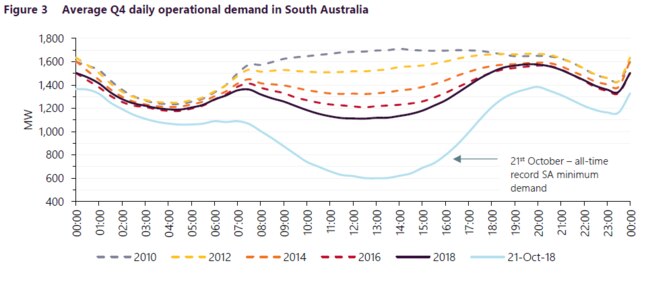Surge in solar leads SA Power Networks to propose sweeping changes to electricity pricing
The massive increase in solar panels has SA Power Networks planning to start charging higher prices for electricity in the evening peak than during the day — and it could start next year. INTERACTIVE: SOLAR POWER FAQ
SA News
Don't miss out on the headlines from SA News. Followed categories will be added to My News.
A cheap “solar sponge” electricity rate to soak up excess energy in the middle of the day and cut prices for consumers is being proposed by South Australia’s electricity distributor.
Savvy consumers would make big savings on their electricity bills under the structural change to how usage is measured.
But in a carrot-and-stick approach, householders who turn on the washing machine, pool pumps and other energy-hungry appliances at peak times would be hit with a penalty rate.
The distributor, SA Power Networks, wants to implement the change next year.
“There is now so much energy being generated from rooftop solar in the middle of the day that it can exceed demand on parts of our network and this ‘solar trough’ poses a very real threat to maintaining network stability,” SAPN spokesman Paul Roberts said.
“The residential tariffs therefore are aimed at encouraging customers to consume more electricity during the middle of the day, when energy is cheap and abundant.”
SAPN says it is difficult to estimate the maximum savings or extra cost on household bills because individual circumstances vary so much.
However, simply recharging an electric vehicle in the middle of the day instead of the evening would save the owner $560 a year.
Many modern household appliances such as dishwashers have delay options built in.
To take advantage of the “solar sponge” a consumer leaving home in the morning for work could set the dishwasher to turn on a few hours later.
In the new structure, different rates would be charged at different times:
SOLAR SPONGE, 10am to 3pm: Charged at a quarter of the standard single rate.
PEAK, 6am to 10am and 3pm to 1am: Charged at 125 per cent of the single rate.
OFF-PEAK, 1am to 6am: Charged at half the price of the single rate.

Overall, SAPN estimates all customers would save an average $40/year and face lower increases in future.
“This will help to lower the future electricity price for all customers by helping to reduce the impact of demand peaks and troughs on the network,” it said.
“This will lower network expenditure in the longer term and increase the amount of low-cost renewable energy distributed locally, translating to future lower energy and network prices.”
Energy and Mining Minister Dan van Holst Pellekaan supported the idea in principle.
“The South Australian Government supports a transition to time-of use tariffs, subject to clear evidence that consumers will benefit from using cheaper power at different times of the day,” he said.
The change would complement the State Government’s home battery and grid-scale storage schemes in lowering prices.
Solar has proved so popular in SA that a third of homes now have panels, cutting demand on the grid in the middle of the day to record lows.
Tariff changes would apply across the board but, initially, only one in five customers would be affected because the proposal requires smart meters.
Smart meters record electricity usage every half-hour, whereas old meters only record accumulated energy used between readings, typically every three months. Customers with old meters would remain on standard rates.
Smart meters have been compulsory on new and replacement installations since 2017 and 45 per cent of homes are expected to have a smart meter by 2025.
Traditionally, cheap off-peak rates at night have required a separate circuit, usually only connected to a hot water system and metered separately.
Now, the various rates would apply to all appliances and devices being used.
The changes would affect only the distribution portion of the cost of electricity.
SAPN estimates that the average SA residential customer’s bill this financial year will total $2090 — with $579 of that SAPN’s cut for distribution and metering.
Other components are generation and retail $1045, environmental schemes $138, transmission also $138 and GST $190.
SAPN has proposed the changes in its application to the Australian Energy Regulator for 2020-25.
The AER decides how much money distribution companies such as SAPN can charge over a five-year period.
It would be up to retailers to decide how they pass on the SAPN changes to customers’ bills.
Retailers are awaiting the regulator’s decision on SAPN’s proposal before taking action.
Origin said it “supports initiatives that help keep prices down, make things simple for customers and promote a smooth transition to a more renewable energy future”.
AGL said it wanted to help customers better manage their energy.
“We generally support cost-reflective tariffs that encourage efficient use of the network and which allow customers with digital meters to save money by using more energy at lower cost times and less at peak times,” AGL interim chief customer officer Mark Enzinger said.
As part of its proposal, SAPN would eliminate the current tariff arrangement where the rate per kWh increases as a household exceeds set thresholds in a day.
In a further change, a new category of consumer with solar and home battery installations would have an option of becoming a “prosumer”.
The prosumer tariff would be linked to their maximum average demand between November and March during the hours of 5pm to 9pm.
SAPN’s proposal is open for comment to the Australian Energy Regulator until May 16.
A final decision by the regulator is expected by April next year.


